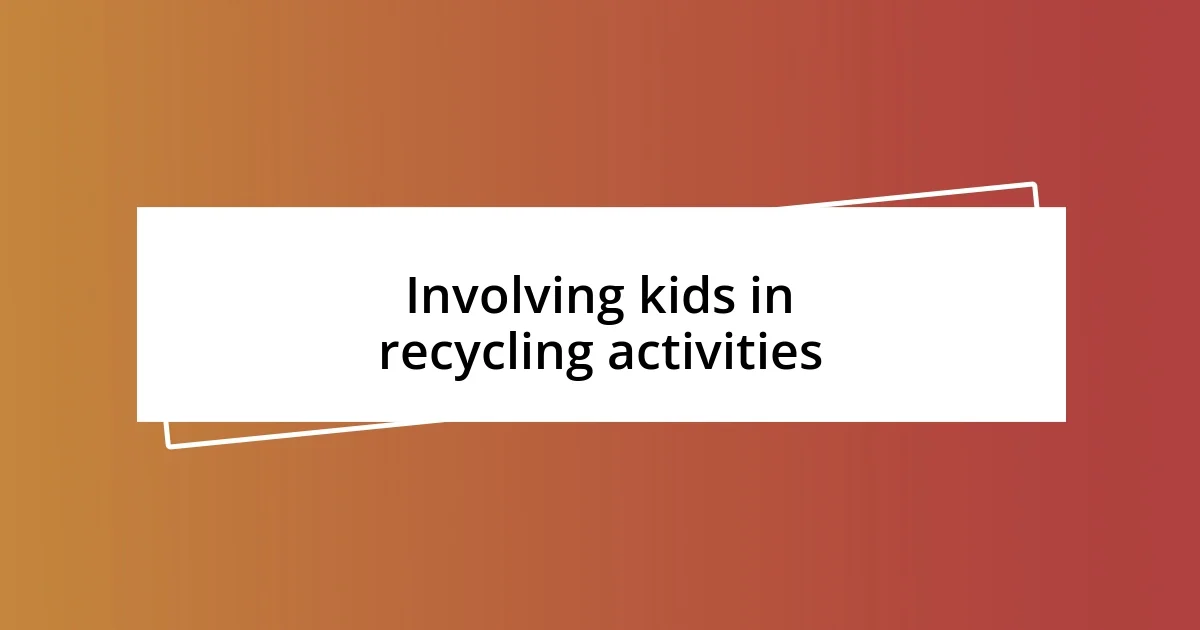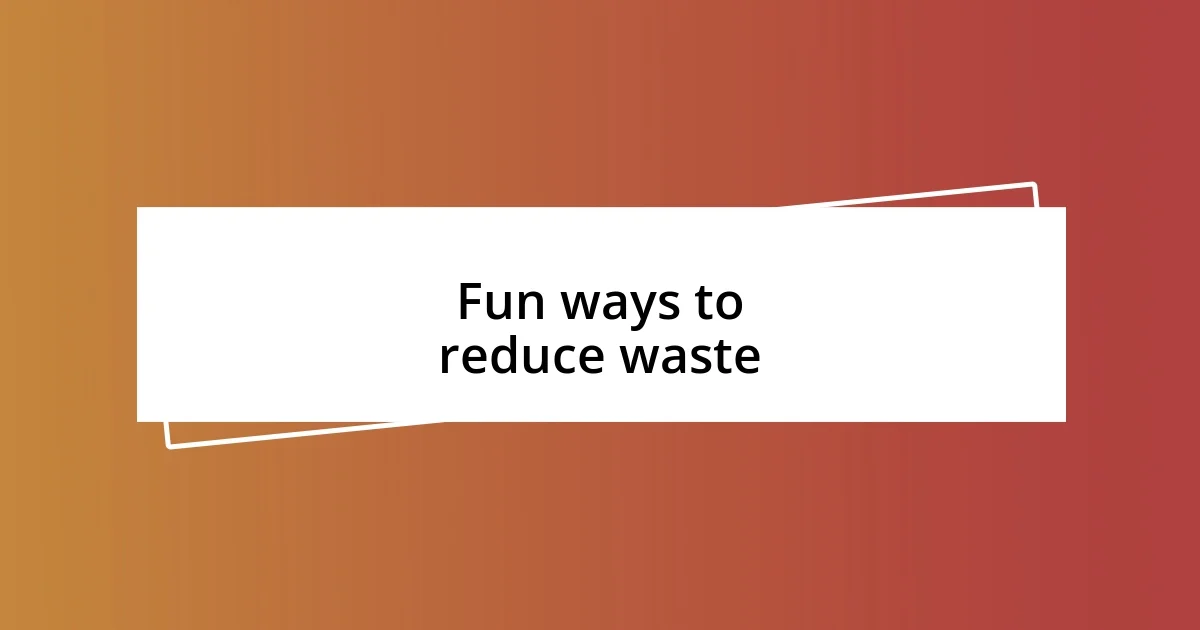Key takeaways:
- Breaking down sustainability into relatable concepts, like comparing Earth to a shared house, helps children grasp their role in environmental care.
- Engaging kids in hands-on activities, such as gardening and recycling challenges, fosters their understanding of sustainability and creates lasting memories.
- Daily practices like “Eco Star of the Week” encourage children to adopt eco-friendly habits, instilling a sense of responsibility and personal achievement in caring for the planet.

Understanding sustainability for kids
Sustainability can be a challenging concept for kids to grasp, but I’ve found that breaking it down into relatable ideas makes all the difference. When I first explained it to my children, I compared our planet to a big house we all share. I asked them, “If we don’t take care of our house, what do you think will happen?” Their eyes lit up with realization, and from that moment, they understood that every action counts.
I remember the day my daughter proudly pointed out how recycling helps create new products. It was heartwarming to see her enthusiasm grow as she sorted plastic bottles. It made me think — if we give kids a tangible connection to concepts like recycling, they’re more likely to engage with them. I realized that showing them how their actions could lead to positive environmental changes empowered them in a way that mere facts never could.
Sometimes, I find myself wondering how kids perceive their role in our collective future. When I engage them in discussions about nature and our responsibilities, I can see the spark of curiosity in their eyes. It’s during these moments that they begin to understand that sustainability isn’t just about rules; it’s about caring for our world and each other. Every little question they ask feels like a step towards becoming environmentally conscious individuals, and that’s incredibly rewarding to witness.

Creating a sustainable home environment
Creating a sustainable home environment starts with small changes that make a big difference. I remember the excitement in my kids’ voices when we decided to create a small indoor garden together. We planted herbs, and it became a fun after-school project. Watching them water and care for the plants, I noticed how their understanding of where our food comes from deepened. It was as if nurturing these plants connected them more to the earth.
In our home, we also focus on energy conservation. I made a little game out of remembering to turn off lights and unplug devices when not in use. My kids love participating and compete with each other to see who can catch the most “energy offenders.” It’s playful yet impactful, underscoring the idea that every effort counts. This approach turned a mundane task into an engaging activity, reinforcing the habit of energy-saving behaviors.
By incorporating sustainable practices into daily routines, I’ve seen my children’s sense of responsibility flourish. For instance, having family meetings to discuss waste reduction strategies always sparks lively conversations. I distinctly remember my son suggesting we start composting, and it was heartwarming to see him take the lead. Such initiatives not only teach them about sustainability but also foster a sense of community and shared purpose in our family.
| Sustainable Practice | Family Engagement |
|---|---|
| Indoor Gardening | Kids learn about food sources and nurturing nature. |
| Energy Conservation Games | Encourages playful competition to save energy. |
| Family Discussions on Waste Reduction | Fosters a sense of responsibility and teamwork. |

Involving kids in recycling activities
Involving kids in recycling activities can be a delightful experience. I remember our first family recycling day; I set up bins in bright colors for paper, plastics, and metals. The kids dove right in, excited to see who could fill a bin the fastest! Their laughter echoed in the kitchen as they raced to find items around the house. It transformed a simple task into a mini-competition that sparked their interest in recycling.
To deepen their engagement, I introduced fun challenges:
– Create a craft from recyclables: I’ve seen my son turn outdated magazines into colorful collages.
– Sorting races: Timing how fast they can sort items helps them learn about different materials.
– Reward systems: We use stickers for every recycled item, and they love tracking their progress on a chart.
These activities not only make recycling fun but also deepen their understanding of its importance. It’s remarkable to see them take ownership of their actions, knowing they’re making a difference in our planet’s health.

Teaching energy conservation practices
I find teaching energy conservation practices to my kids can be both enlightening and enjoyable. One evening, while cooking dinner, I encouraged them to see how we might use less energy. I held a contest to see who could suggest the most energy-saving ideas. They came up with fantastic suggestions, like using the microwave instead of the oven and turning off the TV when we weren’t watching. It was exciting to watch their wheels turn as they grasped the concept that even small changes can positively impact our energy use.
In another instance, we took our family game night to a new level by integrating energy conservation into it. We created a bingo card with different energy-saving tasks—like switching off lights in unoccupied rooms or using natural light instead of lamps. The sheer thrill of checking off boxes made it feel less like chores and more like a shared adventure. I can still hear their cheers every time someone shouted, “Bingo!” The joy in their voices reminded me that lessons in conservation don’t have to be serious; they can be playful too.
Setting an example has also been a vital part of this process. My kids love to mimic what I do, so I made it a point to consistently show energy-conscious habits, like keeping windows closed during hot days to save on air conditioning. I often ask them, “What do you think happens if we leave the door open?” Their responses range from thoughtful to comical, but what truly matters is that these conversations create a mindset geared toward conservation. It’s rewarding to see them internalize these practices as a natural part of our life together.

Garden projects for hands-on learning
One garden project that has truly sparked my kids’ curiosity is creating a butterfly garden. I took a corner of our yard and got them involved in choosing the plants—lilies, daisies, and milkweed. Their eyes lit up as they dug holes and planted seeds, and I could see their pride grow as the first flowers bloomed. It’s mesmerizing to watch them find joy in nurturing their little corner of the world, and I often ask them, “What do you love most about watching the butterflies visit?” Their answers reveal how much they’ve connected with nature’s beauty.
Another engaging project is starting our small vegetable garden. We began by visiting a local nursery to let the kids pick out seeds, and I encouraged them to choose vegetables they wanted to try growing. The excitement was palpable when we sowed the seeds together and later checked for sprouts. They even created a chart to track growth! It’s a wonderful lesson on patience and responsibility, and it opens up discussions on where our food comes from. I’ll often hear them inquire, “Can we eat those when they’re ready?”—a reminder that hands-on learning leads to curiosity about our food systems.
To add an element of fun, we turned our gardening into a scavenger hunt. We’d search for different insects, plants, or even signs of our veggies growing. I remember one day we found a ladybug, and the delight in their voices as they exclaimed, “Look! It’s our garden protector!” This simple act fostered an appreciation for biodiversity and the role each creature plays in maintaining a healthy garden ecosystem. Engaging kids through these garden projects not only teaches them about sustainability but also creates lasting memories that shape their understanding of nature.

Fun ways to reduce waste
One fun way to reduce waste that my kids absolutely love is crafting with recycled materials. I’ve set up a designated “art box” filled with empty cereal boxes, plastic containers, and old newspapers. My children can unleash their creativity, turning what would have been trash into colorful sculptures or unique greeting cards. One day, my daughter transformed a cardboard tube into a telescope—she was so proud as she declared, “Now I can see the stars up close!” It’s a joy to witness their imaginative ideas while subtly teaching them the value of reusing what we already have.
Another engaging activity is hosting “waste-free” challenges during our family nights. We pick a night each month and see who can create the least amount of waste while preparing dinner together. I remember one evening, my son excitedly proclaimed, “I’ll make the salad without any plastic!” It turned into a friendly competition, with each of us brainstorming ways to substitute disposable items with reusable ones. These tasks not only bring us closer together but also turn sustainability into a fun and memorable experience.
One unusual but enjoyable practice we’ve embraced is our “Leftover Lunch Day.” Each week, I invite my kids to turn last night’s dinner leftovers into creative lunch ideas. I recall one Thursday when my son made a quesadilla out of leftover vegetables and beans. He beamed with pride as he presented his dish and said, “Look, Mom! I’m a chef today!” This simple act fosters resourcefulness and encourages them to think critically about food waste—plus, it’s a delicious way to engage with sustainability!

Encouraging eco-friendly habits daily
Encouraging my kids to adopt eco-friendly habits is a daily practice that blends fun with a sense of responsibility. Every morning, we start the day by discussing our green goals over breakfast. I often ask, “What can we do today to help our planet?” It’s amazing to see how their ideas evolve—from using cloth napkins instead of paper to making sure we turn off lights in rooms we leave. These small discussions not only spark their creativity but also instill a sense of purpose in their daily routines.
One of my favorite initiatives has been the “Eco Star of the Week” challenge. Each week, one child picks an eco-friendly habit they’ll focus on, like taking shorter showers or making sure to recycle properly. I remember when my daughter chose to walk to a friend’s house instead of asking for a ride. The excitement in her voice as she reported back, “I felt like I was helping the Earth!” filled me with pride. This approach empowers them to take ownership of their choices, transforming sustainability into a personal achievement.
To add a bit of magic to our eco-friendly practices, I like to incorporate nature-themed games. During one family walk, we played a game where we counted how many items we could spot that were eco-friendly, like reusable bags or solar panels. At one point, my son exclaimed, “Look! More people are going green!” His enthusiasm was contagious and it illuminated how our everyday actions ripple into a larger community effort. This playful exploration reinforces the idea that sustainability is a shared journey and inspires them to actively contribute.














